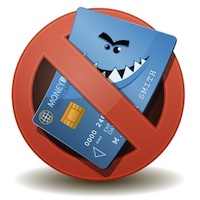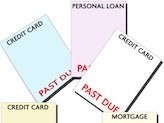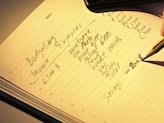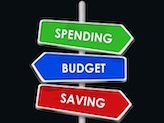Paying Off Debt Will Set You Free

Paying off debt is not difficult, but it does take time, which, in our world of instant everything, can be a bit off-putting.
When faced with a situation that's going to take time to change, it might overwhelm you a little. But breaking free from the debt cycle will be so liberating and will give you a new lease on life, so it's worth a bit of discomfort!
On top of this, the good news is, you can set it up and forget it if you do it correctly. This means that paying off debt doesn’t have to be part of your day-to-day life, you can carry on as normal while it’s going on the background.
So…lets get going...
Make a list of all your debts on a sheet of paper, showing the amount you still owe, the interest payable, and your current minimum repayment amount. You can download a ready-made sheet here.
Now you’ll be able to see the total amount of debt you’re currently paying each month. The next step is to decide which method of paying off debt you prefer:
- The Avalanche Method - may take longer, but you'll pay less interest
- The Snowball Method - see results faster, but may pay more interest
- Credit Card Consolidation - you can pay very low or no interest at all, but have one big debt to pay
- A mixture of the above
First Step – Stop Using Your Cards/Loans!

If you keep using the plastic, or pulling money out of your loans, the only way to make this work is to pay back what you spent PLUS your monthly amount on your next payment date. Otherwise you’re kidding yourself and you’re not gong to get anywhere fast.
Choose one credit card you’re going to keep for emergencies - preferably the one with the lowest interest rate. Get rid of the rest. Cut them up and throw them away. The card you're keeping needs to be kept in a safe place, but not in your purse or handbag.
Stick it under your mum’s mattress – as long as she doesn’t live with you! Freeze it in a plastic bag full of water. Lock it in a draw and give someone else the key. Just do anything with it so that you have to really make an effort to spend on it – it’s there for dire emergencies only.
Make sure you’re paying something into your emergency fund as well as paying off your debt. If you suddenly have to fork out a lot of money and you have to stick it on the card – you’re going backwards. You can organize all this by creating a budget here.
OK, so now to paying off that debt…
Paying Off Debt Using The Avalanche Method
This way of paying off debt will decrease the amount of interest you pay in the long run. You concentrate on one debt first (still paying the minimum on all the others) and put everything you can towards paying it off, before moving on to the next on the list.
So, this is how you set it up....
Take your list and order your debts with the highest interest rate at the top.
Take the total amount you currently pay each month and find some extra money that you can add to it.
If you haven't done a budget yet, you may want to do that first so you can find where you can cut back to get the extra money. You're going to throw everything at this to knock it on the head, so it may mean sacrificing some stuff for a while... but it will be worth it!
Take note of the minimum payment on all your debts as of the date you start and freeze them at that amount. Continue to pay that, even though with credit cards the minimum will decrease with every bill. This way you’re paying a little extra off these accounts every month.
Continue to pay your debts this way, except for debt #1 – add the extra money you've allocated to this payment each month until it’s paid off.
Then go to the next payment on the list and add the extra money plus what you were paying on debt #1 to your monthly repayment until it’s paid off.
Continue down the list adding the amount you were paying on the paid off debts plus the extra amount to each new one on the list.
For example: You have 5 debts on your list with repayments as follows: #1 - $70, #2 - $40, #3 - $120, #4 - $55, #5 - $130 = Total per month $415.
You’ve worked out that on your current earnings you can add an extra $200 per month to your repayments, which makes it $615 per month.
You’ll start by paying $270 ($70+$200) on debt #1 until it’s paid off.
Then you’ll pay $270 + $40 = $310 on debt #2 until it’s paid off…
Then on debt #3 you’ll pay $310 + $120 = $430 per month …. And so on.
When you get to debt #5 you'll be paying $615 per month towards it until it's paid off.
Paying Off Debt Using The Snowball Method
This follows exactly the same principle as the Avalanche method except that instead of listing your debts in order of the highest interest rate first, you order them with the smallest debt first and work your way to the largest at the end of the list.
The reason you would choose this way over the Avalanche method is because you'll pay off the smaller debts quickly, meaning that you get a real sense of achievement by watching the number of debts diminish fast.
Psychologically this motivates you so you're much more likely to keep going, and by the time you start paying off the bigger debts you've already cut a significant amount of debts off the list. You'll also free up larger amounts of money by this stage, which means you pay them off quicker as well.. see below for the example of how this works.
So let’s say, the same as our first example, you find an extra $200 per month that you can add to your debt repayment, and the balance of your smallest debt is $670 with a current minimum payment of $35 per month.
The first month you will pay $235, which means on your 3rd payment you have already paid it off, with some money left over. You're already one debt down with $35 change! Now you can allocate the money to the next one on the list.
Let's say your second debt is $850, and your current monthly repayment is $40. You'll pay $275 per month off this debt ($235 + $40), plus in your first month the extra $35 left from your first debt. In the third month you'll have paid this debt off too, with $10 change!
At this point you've been going 6 months and you've knocked 2 debts off the list by paying just $200 extra each month and started increased payments on your third one! Amazing! This is why paying off debt this way is so powerful, even though you may pay more interest, with the snowball method you really get some momentum going fast...
Go here to download a great free calculator so you can play around with the numbers and see what will work best for you. (Make sure you choose the free calculator which is the first one as you scroll down the page).
Paying Off Debt Using Consolidation
You should only do this if you’ll be paying less interest than you currently are, and if you can pay it all off within a maximum of 3 years. Any longer and it may be a tough call to keep going without losing motivation - the result being that there is a higher chance you will fall off the wagon.
Credit Cards
Do some research and find a card that offers 0% interest (or a really low interest rate) for transferring balances from other cards.
The offer will usually last for about 6 months or so and you need to be able to pay it off within that period to make it work, unless the new card has a lower interest rate than the ones you are transferring from. In that case even when the offer period ends, you are still paying a lower interest rate, so you still win.
I paid off a large credit card debt by transferring all my credit card balances to a 0% interest card, and when the 0% period ran out I transferred the remaining balance to another card with 0% interest offer...
I did the math beforehand and knew I could keep to the repayments over a 12 month period. I paid over $10,000 of credit card debt off within a year this way.
Loans
The same premise applies as for credit cards. Research and find a loan that has a lower interest rate than you’re currently paying and use it to pay off the other loans.
Set It On Automatic...
Once you’ve set up whatever system you want to use – Automate It! Set up automatic payments to cover each debt repayment and forget about it… This way you can start to focus on your future again without the constant thought of paying off debt. David Bach writes about the benefits of this in his book The Automatic Millionaire.
Slow And Steady Wins The (Debt Repayment) Race
When you first start this process and you’re feeling all inspired to get rid of your debt you may feel like setting really high repayment goals to get it paid off quickly. The trouble with this is, after a few months, when the excitement has worn off a bit, you'll end up not being able to stick with it.
It’s better to take an extra few months (or more depending on how much debt you have) to pay it off, but set goals that you can achieve and leave room for living as well. Yes, you may pay a bit more interest, but it's better than lapsing after a few months and using your credit again because you’re sick of sitting at home and living on cereal!
So whatever you choose to do, make it sustainable. If you have a large amount of debt to pay, you must be realistic and understand that it is going to take a couple of years maybe, before it’s all paid off. It took you a while to get into this situation, so it’s going to take you a while to get out again.
It may be a long road if you've spent lots of money you don't really have... but paying off debt is not as hard as it seems. You just need some patience and to keep your mind on the end result - the peace of mind of being totally debt free.
You May Also Be Interested In These...















New! Comments
Have your say about what you just read! Leave me a comment in the box below.